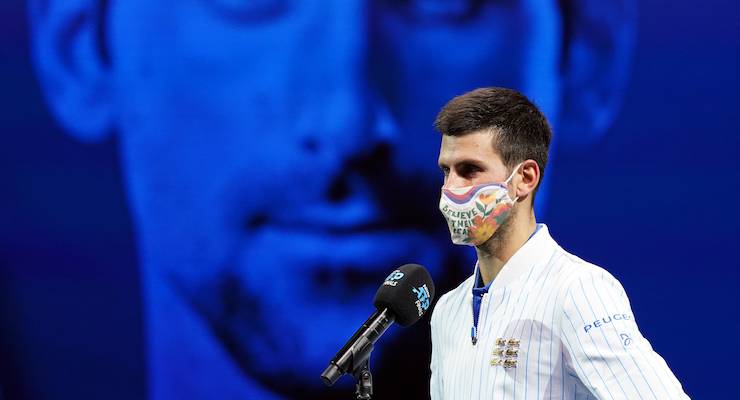
Three weeks out from the start of this year’s Australian Open, and there’s a worrying sense the tournament could all suddenly go disastrously wrong.
Last night, a fifth person on a flight carrying players into Melbourne tested positive to COVID-19. This was the third flight to have a positive case on board which means there are now 72 players stuck in full 14-day quarantine, unable to leave their hotel rooms to train.
Some players are insisting this rule was never communicated to them and that they would never have come to Australia had they known they could be forced to play a grand slam after two weeks without training. Novak Djokovic, who contracted the virus after partying over the European summer, is demanding better food and support for players.
While things haven’t quite derailed yet, there are fears the constant disruption could undermine an event that’s taken on a deeper significance after Melbourne’s 112-day lockdown last year.
Tournament organisers are adamant things will go ahead. But should they?
The system is working
A growing number of cases popping up among participants in hotel quarantine has Melbourne worried. After the city’s experience last year, many residents would rather not take any chances.
But we shouldn’t panic yet. The cases being detected are a “sign the system is working”, according to Deakin University epidemiologist Catherine Bennett.
“This was set up as a very safe operation, and the call to make people close contacts was always communicated,” Bennett told Crikey. “They’re being overly-cautious, but that’s what we’d expect given the experience we’ve had in Victoria. They’re going for safety and then some.”
As for people attending the Open, Bennett says the risk of them getting infected from those who have travelled for the competition is pretty slim.
“I don’t think this changes the risk for people attending the tournament, because the players would have done their quarantine and are screened more than the average traveller.”
Having some people getting infected, even with pre-flight screening, was inevitable, says Australian National University infectious diseases expert Peter Collignon.
“They seem to be doing a reasonable job at managing the risk,” he said.
An Open like no other
The Australian Open is a ritualistic fixture in the nation’s calendars. It marks the end of summer holidays for many, the turning point after which the year gets serious.
But this year’s edition was always going to be different. It’s already been pushed back three weeks, from the traditional mid-January to early February. Players, coaches and officials have had to endure strict quarantine conditions. Fans will be tightly regulated — limited to specific zones, and forced to physically distance inside the arenas.
The 2021 edition has also lost some of its big drawcards. Roger Federer pulled out late last year and Andy Murray, who recently tested positive to COVID-19, is unlikely to make it.
But keeping the Open means a lot to Melbourne. Last year, the event gave Victoria an economic injection of $387 million. International and domestic border closures will mean drastically reduce that figure this year, but the Open would still provide a much-needed boost.
The tournament also has deeper significance. Along with the Boxing Day Test, and the AFL grand final (lost to Brisbane in 2020), the grand slam is one of those big sporting events that Melbourne holds dear.
After Wimbledon was cancelled last year for the first time since World War II, and the French and US Opens both flickered under the shadows of growing COVID-19 cases, a successful tournament could be a big opportunity to remind the world of Melbourne and Australia’s tremendous success in bringing the pandemic under control.
Bad optics
While the Open could be a sign of Australia’s triumphant return to normal, there are plenty of bad optics too.
Thousands of Australians are stuck overseas and unable to get home, while Victoria has put in place onerous restrictions stopping its residents from coming back from NSW. At the same time, around 1200 people from some of the most COVID-raged countries on earth have been allowed in.
Collignon says this situation points to a troubling inconsistency in how governments are managing risk.
“In my mind, people from regional NSW are less of a risk than overseas tennis players,” he said.
“We’ve got to be proportionate, and some of our responses are out of proportion to the risk. We need much better standardisation about what level of risk we’re willing to accept.”
Should the Australian Open go ahead? Let us know your thoughts by writing to letters@crikey.com.au. Please include your full name to be considered for publication in Crikey’s Your Say column.








Despite what the article says, what we see here is not, at its root, risk management. It would not be happening if risk management was the sole concern. This is privilege management. The well-connected and very privileged folk who run major sports organisations get their wishes granted. The tennis players get their privileges, within limits, then whine about it. The ordinary Australians without wealth and privilege get the crappy end of the stick, stuck in a maze of blundering bureaucracy, ever-changing border rules and cancellations.
Not so much risk management as class war.
When practicing risk management a likely ‘likelihood’ rating coupled with a catastrophic (potential for death and/or serious economic impacts) ‘consequence’ rating almost without fail (military operations notwithstanding) should result in the only acceptable approach being to eliminate the resultant risk. The only way to do that is to cease the activity. However, in the context of the global health pandemic we have allowed essential activities to continue with stringent controls. A international tennis tournament is not an essential activity, neither is a international cricket match for that matter. These are nice to have, feel good, distraction activities. Allowing such risk taking is akin to Russian Roulette.
At least the cricket did not permit 1200 participants to enter the country. But both decisions to host the events were reckless.
Not to mention unfair to Australians who should always have priority.
These days being an Australian trapped in a foreign country means bugger all – just ask Julian Assange.
Fair cop, but the ratings given here wouldn’t be likely and catastrophic. Risk would be low and consequence moderate to high. It would be catastrophic only in a political sense, and I’m sure their response times to any outbreak would be swift and harsh, but for a short period.
My reading is that Oz is serving as a proxy for how to manage the Olympic Games come July. We started with the internal AFL grand finals in Qld that were a risk for Anastacia at the time, then Test cricket involving International travel for Gladys to hold firm and finally the Tennis involving significant global travel and numbers for Dan to announce just as the heroics of Victoria and Melbourne were coming to a close.
State governments, particularly the Victorian Government, are beholden to their international sporting events. The Grand Prix is another example.
I wonder if they considered in their management plan the fact that many top players are resident in the USA. Not because infection is rife there – they knew that – but because people living in the USA are going to be largely clueless on how Covid19 is managed properly. In particular there would be little understanding of what is involved in coming to a (largely) Covid free country that wants to stay that way.
Talking about bad optics. Weeks and weeks now, and we still don’t know who was ‘patient zero’ who locked down the Northern Beaches, Sydney and NSW. C’mon St Covid Gladys, surely you know.